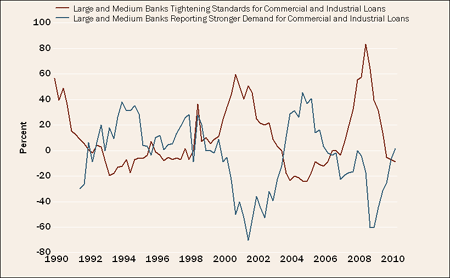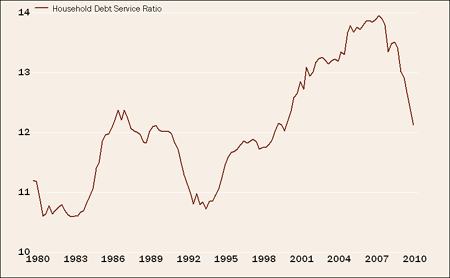This article is a guest contribution by Liz Ann Sonders, Senior Vice President, Chief Investment Strategist, Charles Schwab & Co.
Win, Lose or Draw: Do We Have a Win-Win Scenario?
Key points
- An influential hedge fund manager sparks a market rally with his "win-win" scenario.
- Many are banking on the Federal Reserve's second round of buying back assets, also known as "quantitative easing" (QE2), but there are perils to the strategy, too.
- Investors who are still underweight stocks may want to climb off the "wall of worry."
Apparently, when David Tepper speaks, people listen. Who is David Tepper? He's a hedge fund manager with a spectacular track record, but from whom the public rarely hears. He went on CNBC's Squawk Box early last week to discuss what many heard as a no-lose scenario.
Tepper said he was buying stocks because either the economy would continue to show improvement, or the Federal Reserve would step in with a second round of asset purchases also known as "quantitative easing" (QE2).
He said it was a win-win for the stock market in that if the economy improved, stocks would do well but if it didn't, the Fed would step in with QE2 and "everything" would do well.
If you didn't see the program on which he said it live, you could have tuned in during any point in the day as CNBC was probably replaying his comments. In fact, I listened to a recording of him again this morning. Within seconds of those live comments, the S&P futures staged an impressive turn to the better, so clearly folks were listening.
A win-win?
Since that Tepper appearance, I've been asked many times about whether I agree with the win-win view, especially since I've been on the optimistic end of the spectrum for well over a year. I'm intrigued by the view, not least because so few have a very rosy outlook for either the market or the economy. As I've often said, I'm always most intrigued by the story few are telling, not the story everyone's telling.
But it's never that simple. Indeed, a lot of hope is being pinned on the Fed to get us out of another economic predicament, to the extent that growth falters meaningfully from here.
In its statement following the latest Federal Open Market Committee (FOMC) meeting, a higher level of inflation was mentioned as an explicit goal of more buying back of assets, if it's deemed necessary: "The Committee will continue to monitor the economic outlook and financial developments and is prepared to provide additional accommodation if needed to support the economic recovery and to return inflation, over time, to levels consistent with its mandate."
Pros and cons of QE2
There are competing camps forming as to the benefits and/or necessity of QE2.
Pros
The purpose of buying back assets is for the Fed to buy government debt in order to bring yields, and in turn borrowing rates, down. And, it's not hard to argue the first round of QE was effective in preventing a downward spiral in output and prices, while adding enough liquidity to the financial system to prevent panic and bank runs.
The issue, though, is how QE2 would work this time, given that we're well past the Armageddon phase of the crisis and rates are already at rock-bottom. As noted by BCA Research, "With interest rates at zero, the interaction between money creation and economic output may have changed. Under normal circumstances, the link between the two is interest rates. With nowhere for rates to go, the linkage may have shifted to asset prices and the US dollar."
"As such, it would not be unreasonable for the Fed to target asset prices via QE. A key mistake Japan has made over the past 20 years was to ignore asset price performance, allowing for the sustained erosion in asset prices to continuously inflict damage on both business and consumer balance sheets."
But it's not just asset prices that QE2 could aid. It would also bring down mortgage rates, corporate bond yields and the dollar; while likely boosting business and consumer confidence.
But it's not clear QE2 would have much of an economic effect. The level of interest rates is certainly not the problem today; it's the level of demand. It's also impossible for many homeowners to take advantage of lower mortgage rates to refinance since they owe more on their homes than they're worth. And that brings me to the cons of QE2.
Cons
Consider me more in the con camp. The Fed can control the quantity of money, but it can't control the velocity of money. The former is already ample—it's the latter that's stuck in low gear. You can see this below in a much-used chart of mine.
Quantity up, velocity down

Click to enlarge
Source: FactSet and the Federal Reserve, as of September 24, 2010. Money multiplier = M2 money supply to monetary base ratio.
The Fed has already pumped huge doses of liquidity into the banking system (monetary base, red line), but since lending is anemic, that money is not getting out into the economy to multiply (money multiplier, blue line). What happened to all that money? It went back on the Fed's balance sheet, because banks didn't lend but rather put it back in the Fed.
The first round of QE also didn't help the employment situation, and QE2 isn't likely to, either. In fact, it was the angst expressed by many about a second round of QE that may have led to the Fed toning down its rhetoric about the size of its likely purchases.
What's now dubbed "QE1.5" is the possibility that the Fed will take smaller steps in terms of purchases versus a "shock-and-awe" approach. We'd be more in favor of QE1.5 than QE2.
Two economists, Seth B. Carpenter and Selva Demiralp, recently posted a paper on the Fed's website titled, "Money, Reserves and the Transmission of Monetary Policy: Does the Money Multiplier Exist?"
Here's one of the key revelations from their study: "In the absence of a multiplier, open market operations, which simply change reserve balances, do not directly affect lending behavior at the aggregate level. Put differently, if the quantity of reserves is relevant for the transmission of monetary policy, a different mechanism must be found." In lay terms, that simply means the Fed can increase the amount of money in the system, but it can't force banks to lend or borrowers to borrow that money.
Last week, Charles Plosser, President of the Philadelphia Fed, had this to say: "Monetary policy is not a magic elixir that can solve every economic ill. Doctors must diagnose the disease correctly if they are to prescribe the correct medicine. Otherwise, they could do the patient more harm than good."
Frankly, I think Chuck Schwab may have hit the nail on the head in his op-ed in The Wall Street Journal last weekend when he suggested that the right prescription is for the Fed to raise interest rates. It's certainly not the consensus, but a consideration worth reading about.
"It's the economy, stupid"
Those in the camp who don't believe more QE is appropriate must therefore bank on an improving economy. This is where I'm mildly optimistic.
Not only did we just get an upward revision to second-quarter gross domestic product (GDP), but, in general, the news in the third quarter has been better than in the second quarter.
I don't wear rose-colored glasses, and I am keenly aware of the employment and debt pressures that remain as impediments to stronger economic growth, but I still feel many of the positives are being overlooked.
Economy's strong points
- Manufacturing remains well in expansion territory, with booming industrial production.
- Leading economic indicators turned back up for the second consecutive month.
- The savings rate is a healthy 6%.
- Commodity prices are surging, suggesting strong global growth and trade.
- Initial unemployment claims have moved back down.
- Home prices are up more than 3% from a year ago, and housing starts and pending home sales are tracking higher.
- Personal income and spending are both tracking higher.
- Retailers are beating sales forecasts, as consumer spending increased significantly in August.
- Construction spending surprised on the upside.
- Housing affordability is near all-time highs.
Stock market's strong points
- Last month's gain was the second-strongest September for the S&P 500® index (historically, that's been a good sign for fourth-quarter performance).
- The majority of S&P 500 stocks are above their 200-day moving average.
- Market breadth is bullish.
- The market is entering its election-cycle sweet spot (typically from the midterm election through the third quarter of the pre-election year).
- Venture capital investment is up nearly 50% this year, while initial public offerings are in vogue again (young firms have accounted for 11% of private employment).
- Merger-and-acquisition (M&A) activity is booming again.
On the lending front
We may even be seeing a bottoming of sorts in terms of lending, at least for the commercial side. As you can see in the chart below, the percentage of banks tightening lending standards has come down markedly, while the percentage of banks seeing increased loan demand is accelerating. In fact, this demand line recently crossed above the supply line for the first time in more than six years.
Loan supply/demand fundamentals improving

Click to enlarge
Source: FactSet and the Federal Reserve's Senior Loan Officer Opinion Survey on Bank Lending Practices, as of September 30, 2010.
Even the consumer is in better shape, although I don't expect much in terms of loan demand. In the chart below, you can see that the ratio of debt-service payments to income has dropped dramatically, which suggests consumer spending (70% of GDP) can keep pace with income growth even as consumers continue to deleverage (pay down debt).
Debt burden lessening

Click to enlarge
Source: FactSet and the Federal Reserve, as of June 30, 2010.
Bottom line
I don't believe there's ever a free lunch in investing. I don't believe in win-win scenarios. But, I remain on the side of the market and economic bulls nonetheless. I think the healing process is ongoing and that the United States, along with other developed economies, is experiencing a somewhat natural soft patch within an admittedly mild recovery.
In the event the soft patch intensifies, the Fed will pull out all the stops to reflate the economy, and with bond yields having plunged, the market may already be pushing that to occur. Say what you will about prior monetary and fiscal stimulus, it did succeed in buying time for the private sector to deleverage and for the economy to gain a little traction.
The household sector is well on its way to a healthy deleveraging with debt-to-income having plunged, while the savings rate has surged. Corporate profits have been on fire and M&A activity is heating up. And, segments of the global economy, notably the Asian and Latin American emerging markets, are on fire.
US stocks are not expensive and they're most certainly under-owned. Most individual investors are either pessimistic or indifferent about the stock market, suggesting the "wall of worry"—the contrarian nature of the market to perform best when pessimism is highest—is alive and well.
In the near term, the stock market is likely overbought and I'd frankly like to see a little pullback to improve the sentiment picture. But a strong stock market would be a terrific confidence builder, as Alan Greenspan noted last week.
I may not share David Tepper's win-win outlook, but I can envision a pretty winning environment.
Liz Ann Sonders
Copyright (c) Charles Schwab & Co.











